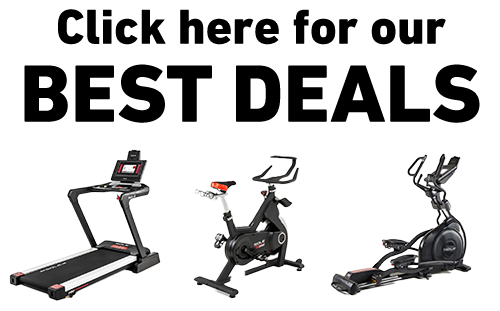Key Takeaways
- Tabata strength workouts deliver impressive muscle-building results through 20-second maximum-effort work intervals followed by 10-second rest periods.
- Kettlebell swings activate your entire posterior chain—hamstrings, glutes, lower back, and shoulders, while teaching your body to generate force rapidly through explosive hip hinge patterns.
- Squat jumps build explosive lower body strength, targeting quadriceps, hamstrings, glutes, and calves simultaneously, while the rapid eccentric loading phase creates substantial muscle tension that stimulates strength adaptations.
- Push-up variations in Tabata format create significant upper body strength gains for chest, shoulders, triceps, and core when progressively overloaded through weighted vests, leverage changes, or plyometric variations.
- SOLE’s strength equipment can help you with your Tabata routine. The SW180 Adjustable Dumbbells enable progressive overload for weighted variations.
Power Up Your Tabata Training in Minimal Time
Looking to build serious strength in minimal time? Tabata training might be your secret weapon.
This 4-minute workout protocol isn't just for cardio enthusiasts—when done with the right exercises, it can dramatically boost strength gains while burning fat. The science-backed approach is transforming strength training for busy fitness enthusiasts everywhere.
The beauty of Tabata for strength lies in its intensity. Developed by Japanese scientist Dr. Izumi Tabata, this method involves 20 seconds of maximum effort followed by just 10 seconds of rest, repeated eight times.
This creates the perfect storm of muscular tension and metabolic stress that triggers strength adaptations even veteran lifters find impressive. When you need efficient strength building, strategic exercise selection delivers results that traditional training methods often can't match in such a compressed timeframe.
|
Revolutionary All-in-One Training System with Game-Changing Motorized Resistance!
Choose Your SRVO System:
Why Choose SOLE SRVO: ✓ Revolutionary motorized resistance technology 30-Day Money-Back Guarantee: Love it or return it, no questions asked. |
1. Kettlebell Swings: The Ultimate Posterior Chain Developer

Kettlebell swings activate your entire posterior chain while teaching your body to generate force rapidly, creating a unique stimulus that traditional strength exercises can't match.
If you could pick just one Tabata exercise for strength development, kettlebell swings should be at the top of your list. This explosive movement activates your entire posterior chain, such as the hamstrings, glutes, lower back, and shoulders, while teaching your body to generate force rapidly.
When performed in Tabata format, swings create a unique stimulus that traditional strength exercises can't match, particularly for power development in the hip hinge pattern.
Proper Form for Maximum Power Output
The kettlebell swing is fundamentally a hip hinge movement, not a squat. Begin with feet shoulder-width apart, kettlebell positioned about a foot in front of you.
Hinge at the hips by pushing your glutes back while maintaining a neutral spine—your chest should remain proud and shoulders packed down.
Grip the kettlebell with both hands and hike it back between your legs like a football snap, creating tension in your hamstrings and glutes.
The power phase is where strength development happens. Explosively drive your hips forward by contracting your glutes, not by pulling with your arms. Your arms act merely as ropes connecting your hips to the weight.
The kettlebell should float to approximately chest or shoulder height as a result of hip power, not arm effort. At the top, your body forms a straight line from ankles to shoulders with glutes fully contracted.
The descent is also important for strength development. Allow the kettlebell to fall naturally while maintaining arm extension, then actively pull it back between your legs as you hinge at the hips again.
This eccentric loading creates the muscle damage necessary for strength adaptations. During Tabata intervals, maintain explosive power on every single repetition—if your swings become slow or arms-dominant, reduce the weight.
Weight Selection for Strength Focus
For Tabata strength development, select a kettlebell that challenges you within the 20-second work interval. Men typically start with 16–24kg (35–53 lbs), while women often begin with 12–16kg (26–35 lbs).
The weight should feel heavy enough that maintaining explosive hip drive becomes challenging in the final seconds of each interval, but not so heavy that form breaks down.
A good test: if you can easily complete 15–20 explosive swings in 20 seconds, the weight is too light for strength development.
Conversely, if you can't maintain explosive hip snap beyond 8–10 repetitions, the weight is too heavy. The sweet spot typically allows 10–15 powerful swings per interval with proper form throughout all eight rounds.
Common Mistakes That Limit Strength Gains
The most prevalent mistake is squatting the weight rather than hinging at the hips. When you squat, you shift emphasis away from the posterior chain and reduce the explosive hip drive necessary for strength development. Your knees should bend slightly during the hinge, but the primary movement comes from pushing your hips back and driving them forward explosively.
Another common error is pulling with the arms and shoulders rather than generating power from the hips. This reduces strength stimulus to the posterior chain and increases injury risk to the shoulders and lower back. Your arms should remain relatively straight throughout the movement, acting as passive connectors between your hips and the weight.
Rounding the lower back during the hinge phase represents the most dangerous mistake. Always maintain a neutral spine position with chest proud and shoulders packed.
If you can't maintain this position throughout all eight Tabata intervals, reduce the weight immediately. Building strength through poor form creates injury patterns that undermine long-term progress.
2. Squat Jumps: Lower Body Power Generator

Squat jumps are the perfect marriage of strength and power development, with rapid eccentric loading creating substantial muscle tension that stimulates unique adaptations.
The beauty of squat jumps in a Tabata format is the progressive fatigue. Your first few jumps might reach impressive heights, but as the 20-second work interval continues, you're forced to maintain output despite growing fatigue.
This trains maximum power production and power endurance—a critical component for athletic strength that traditional strength training often neglects.
Technique for Explosive Strength Development
Begin with feet shoulder-width apart, then descend into a quarter or half-squat position, not a full squat, to optimize the stretch-shortening cycle. Drive through your heels while simultaneously extending your hips, knees, and ankles with maximum force.
Reach for the ceiling with your arms to increase momentum and recruit your shoulder muscles. The landing phase is critical: absorb the impact by returning to the quarter-squat position with soft knees, never locking your joints on landing.
For maximum effectiveness, focus on quality rather than quantity during each 20-second work interval. Five perfect, explosive squat jumps with proper form will deliver better strength results than ten sloppy repetitions. Tabata is about maximum effort, not maximum repetitions.
Keep your chest up and core braced throughout the entire movement. Land mid-foot with knees tracking in line with your toes, never collapsing inward. Imagine landing on eggshells, quiet and controlled, which forces your muscles to decelerate properly rather than letting your joints absorb the impact.
Spend minimal time on the ground, aiming to redirect force upward immediately while maintaining neutral spine position even during maximum fatigue.
Modifications for Different Fitness Levels
Beginners should start with squat-to-calf-raise movements, eliminating the jump while maintaining the explosiveness of the upward phase.
This reduces impact while teaching proper force production. As coordination improves, progress to small jumps focusing on landing mechanics rather than height.
Intermediate athletes benefit from standard squat jumps with emphasis on consistent height throughout all eight Tabata intervals. Use arm drive deliberately to increase power output, and maintain proper landing position even as fatigue accumulates.
Track your jump count per interval; consistent numbers across all rounds indicate true strength development rather than just initial explosiveness.
For extreme difficulty, try squat jumps with a 180-degree rotation, alternating directions with each repetition to challenge your neuromuscular system from multiple angles.
3. Push-Up Variations: Upper Body Strength Builder

Push-ups performed in Tabata format transform this classic exercise into a serious strength developer for chest, shoulders, triceps, and core through progressive overload.
Unlike traditional strength training where you might rest 2–3 minutes between sets, Tabata push-ups challenge your muscles to perform under accumulating fatigue with just 10 seconds of recovery.
This creates a unique stimulus that develops strength endurance while still building maximum strength capacity. The isometric component of maintaining proper plank position throughout also develops core strength that carries over to all other lifting movements.
Standard Push-Up Tabata Protocol
Start in a high plank position with hands slightly wider than shoulder-width, spine neutral, and core engaged. Lower your body until your chest nearly touches the floor, keeping elbows at approximately 45 degrees from your torso, not flared out to the sides.
Push back up explosively while maintaining body alignment. During the Tabata protocol, aim for maximum repetitions with perfect form during each 20-second work interval, completely resting during the 10-second breaks.
For optimal strength development, focus on explosive concentric phases (pushing up) while controlling the eccentric phase (lowering down). This emphasis on rate of force development trains your fast-twitch muscle fibers more effectively than regular-paced push-ups.
Count your repetitions during each interval and try to maintain consistent numbers across all eight rounds; a challenging feat that indicates true strength rather than just endurance.
A common mistake is allowing form to deteriorate as fatigue sets in. The moment your lower back sags, shoulders round forward, or elbows flare excessively, you should scale the exercise to an easier variation. Maintaining technical precision throughout all eight Tabata intervals ensures continuous strength gains while preventing injury.
4 Progressive Variations to Increase Difficulty
Begin with incline push-ups against a bench. As strength improves, progress to standard push-ups, then add intensity through these variations:
Decline push-ups using a bench to elevate your feet increase upper chest and shoulder activation significantly. Position feet on the bench with hands on the mat for stable, controlled pressing that shifts emphasis toward anterior deltoids while maintaining chest engagement.
Diamond push-ups with hands forming a diamond shape under your chest emphasize triceps development while requiring greater core stability. This variation typically reduces repetition counts by 30–40% compared to standard push-ups, making it ideal for continued strength progression.
Archer push-ups involve extending one arm laterally while the other performs the push-up, developing unilateral strength that corrects imbalances and challenges stabilizer muscles intensely. Alternate sides every other repetition during Tabata intervals.
Plyometric push-ups with a hand clap or maximum height at the top of each repetition develop explosive pressing power. These advanced variations require significant strength—master standard push-ups for all eight intervals before attempting plyometric work.
Build Maximum Strength with SOLE's Complete System

SOLE Equipment Mat provides the essential foundation for Tabata strength training, offering superior cushioning for explosive squat jumps that protect ankles, knees, and joints.
The non-slip surface of the SOLE Equipment Mat prevents sliding during explosive squat jump takeoffs and push-up intervals, crucial for maintaining proper form when generating maximum power output during those critical 20-second work intervals.
The easy-clean material handles sweaty Tabata sessions while maintaining grip throughout all eight rounds, and the stable platform enables confident execution of plyometric push-up variations without equipment shifting during maximum effort.
The SW180 and SW155 Adjustable Dumbbells enable precise progressive overload essential for continued Tabata strength development. The 16 weight options from 5–80 pounds support systematic progression across all fitness levels.
The SW116 Weight Bench provides the progressive push-up variations essential for upper body strength development through Tabata protocols.
The 9 adjustable positions let you gradually build strength. Start with high incline settings, reducing bodyweight load for beginners, progress to flat positions as pressing strength develops, then advance to decline angles, dramatically increasing resistance and upper chest activation.
The SR550 Rowing Machine delivers full-body conditioning for active recovery days between intense Tabata strength sessions. The low-impact nature protects joints while maintaining the cardiovascular fitness necessary for completing eight demanding Tabata intervals with maximum effort throughout.
All of our equipment comes with the free SOLE+ App, which gives you access to structured strength programs to develop proper form and correct mistakes.
Check out SOLE strength equipment today!
Frequently Asked Questions (FAQs)
How often should I do Tabata strength workouts per week?
For optimal results, incorporate Tabata strength workouts 2–3 times per week, allowing at least 48 hours between sessions that target the same muscle groups. This frequency provides enough stimulus for strength adaptations while allowing adequate recovery time. Beginners might start with just once weekly, while advanced athletes could potentially handle four sessions if properly programmed within their overall training schedule.
Can Tabata truly build strength or is it mainly for conditioning?
While Tabata protocol was originally designed for conditioning, it absolutely can build strength when implemented with the right exercises and loading parameters. The key difference is that Tabata builds strength endurance and power output rather than absolute maximum strength, making it complementary to rather than a replacement for traditional strength training.
What's the difference between Tabata for strength vs. fat loss?
Tabata for strength focuses on exercises that create maximum mechanical tension and challenge your force production capacity, often using added resistance or more challenging movement patterns. You'll select weights that become challenging within the 20-second work period and focus on quality repetitions rather than maximum calorie burn. In contrast, Tabata for fat loss typically employs full-body movements that elevate heart rate dramatically, often using lighter loads or bodyweight movements that allow higher repetition counts and greater total work output.
How do I know when to increase the difficulty of these exercises?
It's time to increase difficulty when you can complete all eight Tabata intervals with consistent repetition counts throughout. If your performance doesn't significantly drop between the first and last interval, you've adapted to the current challenge level. For kettlebell swings, consider increasing weight when you can maintain proper form and hip power throughout all intervals. For squat jumps, progress when you can land with proper mechanics even in the final intervals. For push-ups, advance when you consistently perform at least 8–10 quality repetitions in each 20-second work period.
How does SOLE equipment support Tabata strength training with progressive overload and proper form?
SOLE equipment provides the complete foundation for effective Tabata strength training through progressive resistance, joint protection, and structured programming. The Equipment Mat is essential for Tabata push-ups and squat jumps, offering superior cushioning that protects wrists, hands, and joints during explosive movements and high-impact landings that create the eccentric loading necessary for strength adaptations. The SW180 Adjustable Dumbbells enable precise progressive overload for Tabata strength development with 16 weight options from 5–80 pounds, while the SW116 Weight Bench provides multiple angle adjustments for progressive push-up variations that systematically increase difficulty.





Leave a comment
This site is protected by hCaptcha and the hCaptcha Privacy Policy and Terms of Service apply.